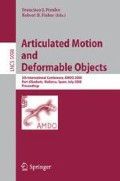Abstract
In this paper we present a novel method called Temporal Nearest End-Effectors (TNEE) to automatically classify full-body human actions captured in real-time. This method uses a simple representation for modeling actions based exclusively on the recent positions of the user’s end-effectors, i.e. hands, head and feet, relative to the pelvis. With this method, the essential information of full-body movements is retained in a reduced form. The recognition procedure combines the evaluation of the performed poses and the temporal coherence. The performance of TNEE is tested with real motion capture data obtaining satisfactory results for real-time applications.
Access this chapter
Tax calculation will be finalised at checkout
Purchases are for personal use only
Preview
Unable to display preview. Download preview PDF.
References
Liu, G., Zhang, J., Wang, W., McMillan, L.: Human Motion Estimation from a Reduced Marker Set. In: Proceedings of the 2006 Symposium on Interactive 3D Graphics and Games, Boston, MA, USA (2006)
Breiman, L.: Random Forests. Machine Learning 45(1), 5–32 (2001)
Boulic, R., Varona, J., Unzueta, L., Peinado, M., Suescun, Á., Perales, F.J.: Evaluation of on-line analytic and numeric inverse kinematics approaches driven by partial vision input. Virtual Reality 10, 48–61 (2006)
Wren, C., Azarbayejani, A., Darrell, T., Pentland, A.: Pfinder: Real-time Tracking of the Human Body. IEEE Transactions on Pattern Analysis and Machine Intelligence (1997)
Theobalt, C., Magnor, M., Schueler, P., Seidel, H.P.: Combining 2D Feature Tracking and Volume Reconstruction for Online Video-Based Human Motion Capture. In: Proceedings of Pacific Graphics, Beijing, China, pp. 96–103 (2002)
Kolsch, M., Turk, M.: Fast Hand Tracking with Flock of Features and Multi-Cue Integration. In: Proceedings of the IEEE Computer Society Conference on Computer Vision and Pattern Recognition Workshops (2004)
Varona, J., Buades, J.M., Perales, F.J.: Hands and face tracking for VR applications. International Journal of Systems & Applications in Computer Graphics 29, 179–187 (2005)
Gonzàlez i Sabaté, J.: Human Sequence Evaluation: the Key-Frame Approach. PhD Thesis. University of Barcelona. Bellaterra, Spain (2004)
Jain, A.K., Duin, R.P.W., Mao, J.: Statistical Pattern Recognition: A Review. IEEE Transactions on Pattern Analysis and Machine Intelligence 22(1), 4–37 (2000)
Mitchel, T.: Machine Learning. McGraw-Hill, New York (1997)
Ibarguren, A., Maurtua, I., Sierra, B.: Recognition of sign language in real time through Data Gloves. In: Borrajo, D., Castillo, L., Corchado, J.M. (eds.) CAEPIA 2007. LNCS (LNAI), vol. 4788, pp. 307–316. Springer, Heidelberg (2007)
Ibarguren, A., Maurtua, I., Sierra, B.: Layered Architecture for Real-Time Sign Recognition (Submitted to The Computer Journal)
Author information
Authors and Affiliations
Editor information
Rights and permissions
Copyright information
© 2008 Springer-Verlag Berlin Heidelberg
About this paper
Cite this paper
Mena, O., Unzueta, L., Sierra, B., Matey, L. (2008). Temporal Nearest End-Effectors for Real-Time Full-Body Human Actions Recognition. In: Perales, F.J., Fisher, R.B. (eds) Articulated Motion and Deformable Objects. AMDO 2008. Lecture Notes in Computer Science, vol 5098. Springer, Berlin, Heidelberg. https://doi.org/10.1007/978-3-540-70517-8_26
Download citation
DOI: https://doi.org/10.1007/978-3-540-70517-8_26
Publisher Name: Springer, Berlin, Heidelberg
Print ISBN: 978-3-540-70516-1
Online ISBN: 978-3-540-70517-8
eBook Packages: Computer ScienceComputer Science (R0)

